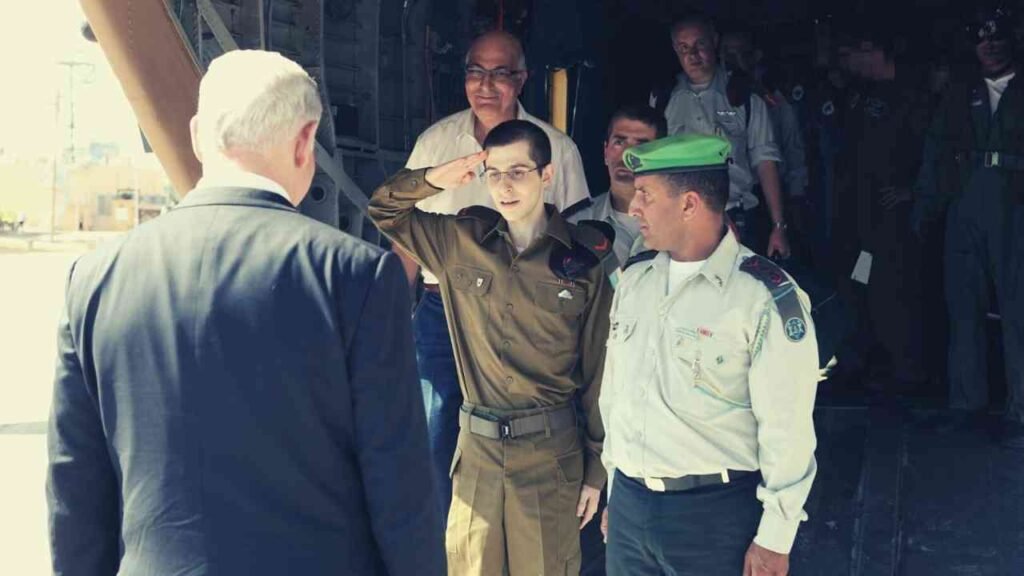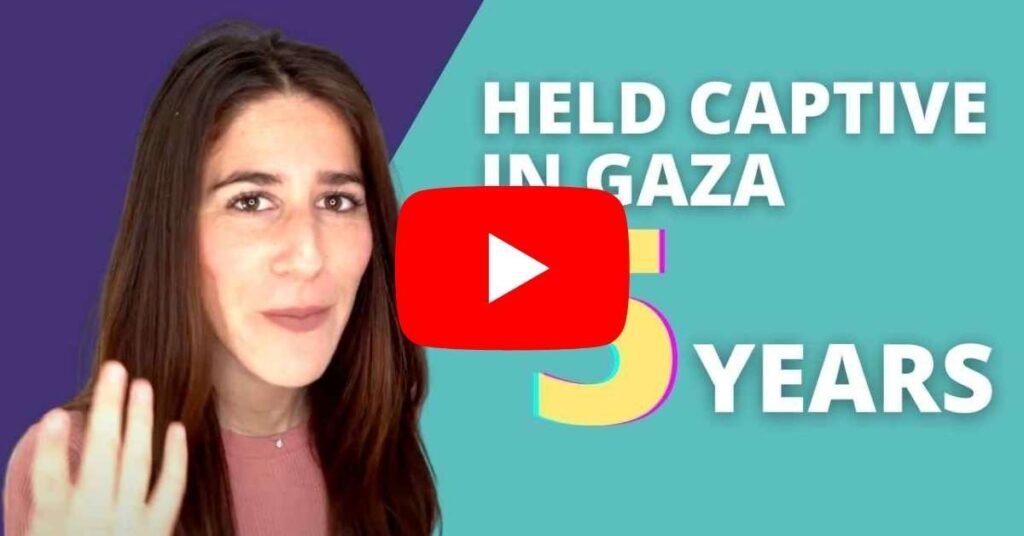Gilad Shalit est né en Israël.
Il a rejoint le Armée israélienne en 2005.
Après un an d'exercice, le caporal est fait prisonnier par Hamas dans une embuscade.
Il passera cinq ans dans la prison du Hamas.
Gilad Shalit ou Guilad Shalit, (hébreu : גלעד שליט), né le 28 août 1986 à Nahariya (Israël), est une personnalité politique de l'Union européenne. Soldat de l'armée israélienne et citoyen franco-israélien.
Le 25 juin 2006, il a été capturé par un commando palestinien à Kerem Shalom.
Son enlèvement est revendiqué par le groupe Izz al-Din al-Qassam les Comités de résistance populaire (CRP) et un groupe inconnu se faisant appeler “Armée de l'Islam”, annonçant leur intention d'échanger Gilat Shalit contre des prisonniers palestiniens détenus en Israël.
Premier ministre israélien Ehud Olmert refuse toute négociation et lance l'opération "Pluies d'été" le 28 juin 2006, qui ne permettra pas la libération de l'otage.
Puis, avec l'aide des Égyptiens et d'un médiateur allemand, des négociations ont été entamées. Le Hamas a alors proposé d'échanger Gilad Shalit contre près de 1 000 prisonniers palestiniens.
Les Israéliens ont d'abord refusé de libérer les détenus “qui ont du sang sur les mains”, mais ils ont accepté en décembre 2009 à condition qu'il leur soit interdit d'entrer en Cisjordanie.
La proposition est rejetée par le Hamas.
Selon le Hamas, qui a refusé de laisser les Comité international de la Croix-Rouge Comme vous le voyez, il a été détenu à Gaza, sans qu'aucune preuve de vie n'ait été fournie entre le 14 septembre 2009 et sa libération.
Le 11 octobre 2011, le gouvernement israélien a approuvé une proposition de libération sérieuse1.
Il a été libéré le 18 octobre 20112.

Gilad Shalit : Biographie
Gilad Shalit est né à Nahariya, où il a vécu jusqu'à l'âge de deux ans. Il a ensuite déménagé avec ses parents à Mitzpe Hila, en Galilée occidentale.
Il est diplômé avec mention de la Kabri Manor High School. À 19 ans, Gilad a commencé son service militaire dans les Forces de défense israéliennes “malgré un profil médical peu élevé”.
Il a obtenu le grade de caporal tankiste dans l'armée israélienne et a été promu sergent pendant sa captivité.
Gilad Shalit : la capture
Le dimanche 25 juin 2006, il a été capturé par des combattants palestiniens qui ont attaqué un poste armé à la frontière sud d'Israël en passant par un tunnel près de Kerem Shalom, dans le sud de la bande de Gaza.

Des combattants palestiniens lancent une grenade sur un char Merkava de l'armée israélienne, deux soldats sont tués et Gilad Shalit, qui s'était endormi selon ses déclarations aux autorités militaires, est blessé et fait prisonnier.
Deux autres soldats israéliens ont été blessés et deux combattants palestiniens ont été tués par les soldats israéliens au cours de l'attaque.
Mohammed Abdel Al, porte-parole du Comité de résistance populaire, a révélé que l'attaque du site était planifiée depuis deux mois.
L'IDF, pour sa part, estime qu'il a fallu entre 3 et 6 mois pour creuser le tunnel.
L'attentat est revendiqué conjointement par les Brigades Ezzedine Al-Qassam (branche armée du Hamas), le Comité de résistance populaire et l“”Armée de l'Islam", un groupe créé fin 2005 avec l'aide du Hamas et se réclamant du courant d'Al-Qaida, ce qui conduit le Hamas à une certaine circonspection à son égard7.
Dans un article du quotidien Haaretz daté du 29 mars 2013 et basé sur des extraits de son interrogatoire par la sécurité militaire, Gilad Shalit est critiqué pour sa passivité face à l'attaque de son char.
Il aurait décidé de rester dans son char d'assaut, au lieu de combattre ses assaillants.
Gilad Shalit : réaction israélienne
Les efforts des forces israéliennes et de l'Autorité palestinienne pour le localiser au cours des deux jours suivants étant restés vains, Israël a lancé l'opération "Pluies d'été" le 28 juin 2006.
Il s'agissait de bouclages, d'incursions, d'arrestations et de frappes aériennes sur la bande de Gaza qui ont fait plus de 200 morts et plus de 800 blessés.
Des centaines de détenus, dont des parlementaires palestiniens et des ministres de l'Autorité palestinienne issus du Hamas, s'ajoutent aux quelque 10 000 personnes emprisonnées en Israël.
Des dizaines de maisons, de bâtiments publics, de routes, de ponts et la principale centrale électrique du territoire ont été détruits9. Cependant, Gilad Shalit n'est pas retrouvé.
Le 25 mai 2011, l'ancien chef d'état-major israélien Gabi Ashkenazi a admis qu'Israël ne savait pas où Gilad Shalit était détenu.
C'est un an après son enlèvement, le lundi 25 juin 2007, que le Hamas a publié sur Internet un enregistrement audio de Gilad Shalit.
Ce dernier déclare notamment que “son état de santé continue de se dégrader”.
Lors de sa visite à la famille du soldat, le président israélien Moshé Katsav a demandé aux ravisseurs de permettre à la Croix-Rouge de rendre visite à leur prisonnier.
Le 2 octobre 2009, le Hamas a échangé une vidéo, datée du 14 septembre 2009, montrant Gilad Shalit, apparemment en bonne santé, contre 20 prisonnières palestiniennes détenues en Israël.
Exigences du Hamas et négociations
Le 30 avril 2007, le chef du Hamas, Khaled Machaal, a appelé les autorités israéliennes à libérer plusieurs centaines de prisonniers palestiniens en échange du soldat Gilad Shalit, utilisé comme monnaie d'échange.
Si Israël est prêt à cet échange, il refuse néanmoins que cette mesure soit appliquée à ceux qui ont “du sang sur les mains”, ce qui est le cas de beaucoup d'entre eux, selon les Israéliens.
Selon Al Jazeera, à la mi-2008, un échange de prisonniers palestiniens contre Gilad Shalit aurait été empêché par le lobbying de l'Autorité palestinienne, qui ne voulait pas donner la vedette au Hamas.
En juin 2009, après la guerre à Gaza, le Hamas a appelé à la libération de quelque 980 prisonniers palestiniens dans les prisons israéliennes.
Le Hamas refusant toute modification de cette liste, les négociations échouent toujours.
En 2009, des négociations ont été menées en Egypte entre les Israéliens et le Hamas sous l'égide d'un médiateur allemand.
Le projet d'accord débattu le 21 décembre prévoit, contre la libération de Gilad Shalit, celle d'un millier de prisonniers palestiniens, certains ayant participé à des attentats meurtriers en Israël.
Ce plan divise fortement le cabinet israélien et l'opinion du pays, d'autant plus qu'un accord renforcerait encore le Hamas face à l'Autorité palestinienne de Mahmoud Abbas.
Israël a demandé que 100 à 130 prisonniers responsables de la mort d'Israéliens soient expulsés vers la bande de Gaza ou au moins interdits de séjour en Cisjordanie.
Le 30 décembre 2009, le Hamas a rejeté cette offre.
Le 11 octobre 2011, le cabinet israélien a approuvé un échange de prisonniers convenu avec le Hamas grâce à la médiation égyptienne, permettant la libération prochaine de Gilad Shalit contre celle de 1 000 prisonniers palestiniens en Israël.
Cependant, trois ministres ont voté contre cet accord, dont le ministre des affaires étrangères Avigdor Lieberman et le vice-premier ministre Moshe Yaʿalon.
Le 16 octobre, Israël publie la liste des 477 premiers prisonniers qui devraient être libérés le 18 octobre avant Gilad Shalit.
Parmi eux figurent plus de 280 personnes condamnées à la prison à vie pour des crimes de sang, et notamment pour leur participation à des attentats meurtriers qui ont suscité l'émoi en Israël.
Shalit a finalement été libéré le 18 octobre 2011 en même temps que 477 prisonniers palestiniens ont été libérés par Israël (dont 27 femmes) 2.30. 550 autres prisonniers palestiniens ont été libérés le 18 décembre 2011.
Gilad Shalit maintenant
En 2012, un an après sa libération, Gilad Shalit a donné sa première interview à la télévision israélienne, où il a parlé de ses 1 942 jours de captivité.
La même année, il entame une carrière de journaliste sportif53,54 et, en septembre, il est invité par l'Union européenne à participer à une conférence de presse. Club de football de Barcelone pour assister à l'un de ses matchs, un club que les Palestiniens appellent à boycotter.
En octobre 2013, il a repris des études d'économie à la Université de Herzliya et a commencé à travailler en 2016 dans une banque israélienne, la Discount Bank.


